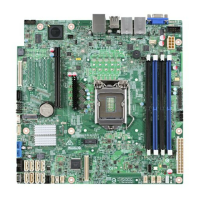Intel® Server Board S1200SP Family Technical Product Specification
1
1 Introduction
This Technical Product Specification (TPS) provides board specific information detailing the features,
functionality, and high-level architecture of the Intel® Server Board S1200SP family.
Design-level information related to specific server board components and subsystems can be obtained by
ordering External Product Specifications (EPS) or External Design Specifications (EDS) related to this server
generation. EPS and EDS documents are made available under NDA with Intel® and must be ordered through
your local Intel® representative. See the Reference Documents section for a list of available documents.
1.1 Chapter Outline
This document is divided into the following chapters:
• Chapter 1 – Introduction
• Chapter 2 – Overview
• Chapter 3 – Functional Architecture
• Chapter 4 – System Security
• Chapter 5 – Intel
®
Technology Support
• Chapter 6 – Platform Management Functional Overview
• Chapter 7 – Advanced Management Feature Support (RMM4)
• Chapter 8 – On-board Connector/Header Overview
• Chapter 9 – Jumper Blocks
• Chapter 10 – Intel
®
Light Guided Diagnostics
• Chapter 11 – Environmental Limits Specifications
• Chapter 12 – Server Board Power Distribution
• Appendix A – Integration and Usage Tips
• Appendix B – Integrated BMC Sensor Tables
• Appendix C – POST Code Diagnostic LED Decoder
• Appendix D – POST Code Errors
• Appendix E – Supported Intel
®
Server Chassis
• Glossary
• Reference Documents
1.2 Server Board Use Disclaimer
Intel® server boards support add-in peripherals and contain a number of high-density Very Large Scale
Integration (VLSI) and power delivery components that need adequate airflow to cool. Intel ensures through
its own chassis development and testing that when Intel server building blocks are used together, the fully
integrated system will meet the intended thermal requirements of these components. It is the responsibility
of the system integrator who chooses not to use Intel® developed server building blocks to consult vendor
datasheets and operating parameters to determine the amount of airflow required for their specific application
and environmental conditions. Intel Corporation cannot be held responsible if components fail or the server
board does not operate correctly when used outside any of their published operating or non-operating limits.

